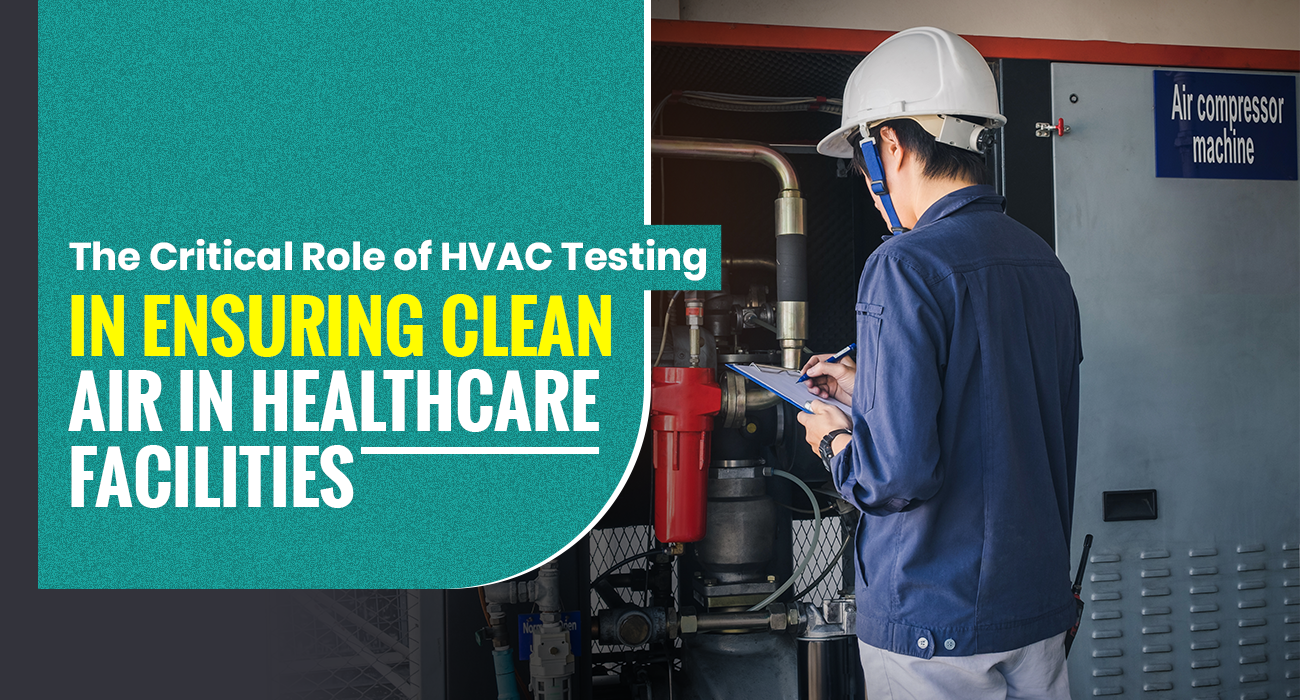
The Critical Role of HVAC Testing in Ensuring Clean Air in Healthcare Facilities
Maintaining safe and sterile indoor environments is fundamental to healthcare delivery. In hospitals, clinics, laboratories, and other medical facilities, the quality of indoor air directly impacts patient outcomes, infection control, staff safety, and regulatory compliance. One of the most effective ways to manage indoor air quality (IAQ) is through HVAC testing, which assesses whether heating, ventilation, and air conditioning systems are operating according to healthcare standards.
In this detailed post, we will explore how HVAC testing works, why it’s critical in healthcare facilities, what testing procedures involve, and how it contributes to the overall safety, compliance, and operational efficiency of medical buildings. We will also highlight the best practices followed by leading inspection and testing providers like Cornerstone Middle East.
The Link Between Indoor Air Quality and Health Outcomes
Healthcare environments are home to vulnerable patients, including those recovering from surgery, undergoing immunosuppressive treatments, or battling infectious diseases. These patients are particularly sensitive to pollutants, allergens, bacteria, and viruses in the air. A well-maintained HVAC system helps:
- Prevent airborne transmission of diseases
- Control temperature and humidity levels
- Ensure sterile air supply in critical zones
- Avoid cross-contamination between departments
To verify that HVAC systems perform these functions correctly, HVAC testing is necessary at installation, during periodic maintenance, and after system modifications.
What Is HVAC Testing and Why Is It Crucial?
HVAC testing is a structured process used to inspect, measure, and verify the operational parameters of HVAC systems. In healthcare settings, testing ensures that ventilation, filtration, pressure control, and temperature/humidity management systems function according to international standards.
Unlike standard buildings, healthcare facilities require higher air exchange rates, tighter pressure controls, and cleaner air. HVAC testing confirms whether the design and performance match requirements such as:
- Air change rates per hour (ACH)
- Room pressurization (positive or negative)
- HEPA filter efficiency
- Temperature and relative humidity stability
- Particle count and microbial contamination limits
Testing is not just about checking numbers; it helps detect potential hazards before they cause harm, ensuring life-critical systems operate within safe margins.
Detailed Procedures Included in HVAC Testing
In a healthcare facility, HVAC testing covers multiple critical areas. Below are the core components and what each test involves:
1. Airflow Measurement and Balancing
Accurate airflow is crucial for maintaining indoor air quality. Using digital anemometers and airflow capture hoods, technicians measure:
- Supply and return air volumes
- Face velocities at diffusers and exhausts
- Cross-contamination risk in mixed-use areas
Correct airflow ensures that clean air enters critical zones like ICUs and operating rooms, while contaminated air is removed efficiently from isolation areas.
2. Room Pressure Differential Testing
Healthcare areas use pressure zones to control airflow:
- Positive pressure in operating theaters keeps airborne contaminants out.
- Negative pressure in isolation rooms prevents infection from escaping.
Pressure differential testing uses micromanometers to verify that required gradients (typically 2.5 Pa–15 Pa) are maintained at all times.
3. HEPA Filter Integrity Testing
HEPA filters remove fine particles and microorganisms. Testing includes:
- DOP/PAO Testing (Dispersed Oil Particulate or Poly Alpha Olefin)
A challenge aerosol is introduced, and detectors scan for leaks downstream. - Visual inspection of seals and gaskets
- Pressure drop monitoring across filters
Inadequate filter integrity can render a “cleanroom” ineffective, risking airborne contamination.
4. Duct Leakage and Cleanliness Assessment
Leaks in the ductwork compromise airflow balance and allow ingress of unfiltered air. Technicians use pressurization and airflow measurement to detect:
- Duct leakage (quantified as CFM/100 ft²)
- Particulate build-up, mold, or microbial colonies inside ducts
- Corrosion or insulation damage that affects performance
This is especially critical in surgical areas, where airborne particulates can cause post-operative infections.
5. Temperature and Humidity Validation
Thermal comfort and microbial control depend on maintaining appropriate temperature and humidity levels. Testers use calibrated sensors and data loggers to confirm:
- Consistency with design specs (e.g., 22°C ±2°C and 40%–60% RH)
- System responsiveness to fluctuations
- Control system accuracy and calibration
Incorrect conditions can lead to condensation, mold growth, or discomfort, affecting both patients and medical staff.
6. Ventilation Rate Testing (Air Changes per Hour)
Hospitals require a high number of air changes per hour (ACH) to ensure fresh air delivery and contamination dilution:
- Operating rooms: 20–25 ACH
- ICUs: 12–15 ACH
- Isolation rooms: 12 ACH (minimum)
Airflow measuring devices and tracer gas methods are used to calculate real-time ACH. Testing ensures that the facility adheres to ASHRAE 170 or ISO 14644 standards.
7. Airborne Particle Count and Microbial Sampling
Cleanliness is verified using:
- Laser particle counters (for particles ≥0.3 μm and 0.5 μm)
- Agar plates and impaction samplers (for microbial growth)
High counts may indicate inadequate filtration, stagnant airflow, or environmental contamination. These results help in compliance reporting and risk assessments.
Commissioning and Re-Commissioning: Ensuring Lifecycle Performance
Healthcare HVAC systems are complex and often upgraded or modified. Commissioning is performed when systems are first installed to verify baseline performance. Re-commissioning is necessary:
- After renovation or repurposing of clinical areas
- Following complaints of poor IAQ
- After long-term system idle periods (e.g., post-COVID lockdown)
Both processes involve full HVAC testing to validate:
- Functional performance
- System integration (with alarms, BMS, etc.)
- Calibration of sensors and controls
- Detailed reporting and certification
Cornerstone Middle East offers commissioning services that adhere to global standards, with detailed logs and traceable test documentation.
Compliance with Healthcare Standards and Legal Requirements
Non-compliance with HVAC-related health regulations can lead to severe consequences, including:
- Regulatory fines
- Revocation of operating licenses
- Civil litigation in cases of patient harm
Global standards referenced in HVAC testing include:
- ASHRAE 170 – Ventilation of Health Care Facilities
- ISO 14644 – Cleanroom classifications
- HTM 03-01 (UK NHS standard)
- WHO Guidelines on IAQ in Healthcare Settings
HVAC test results help facilities prove compliance and provide transparency during inspections or audits.
Technology Used in Modern HVAC Testing
Modern HVAC testing is performed using high-precision instruments, such as:
- Thermal anemometers and flow hoods – For airflow validation
- Micromanometers – For differential pressure checks
- HEPA filter photometers – For aerosol leak detection
- Data loggers – For environmental condition tracking over time
- Particle counters – For cleanroom classification
- Infrared cameras – For thermal imaging of ducts and HVAC components
Using these technologies, even the smallest inefficiencies or failures are detected and corrected before they compromise patient safety.
Conclusion: Making HVAC Testing a Healthcare Priority
In healthcare, there is no margin for error when it comes to indoor air quality. HVAC testing is a critical control measure that ensures hospitals and clinics maintain a clean, safe, and regulatory-compliant environment. Whether it’s during initial commissioning or part of ongoing maintenance, testing reveals performance gaps and allows timely interventions.
From reducing airborne infections to enhancing patient recovery and staff productivity, the benefits of regular HVAC testing are substantial and measurable. Partnering with experts like Cornerstone Middle East ensures your facility remains at the forefront of safety, compliance, and operational excellence.
Healthcare administrators should adopt a proactive approach—schedule regular HVAC testing, maintain thorough documentation, and invest in system upgrades when necessary. In doing so, they protect not only infrastructure but also the lives entrusted to their care.





Post a comment